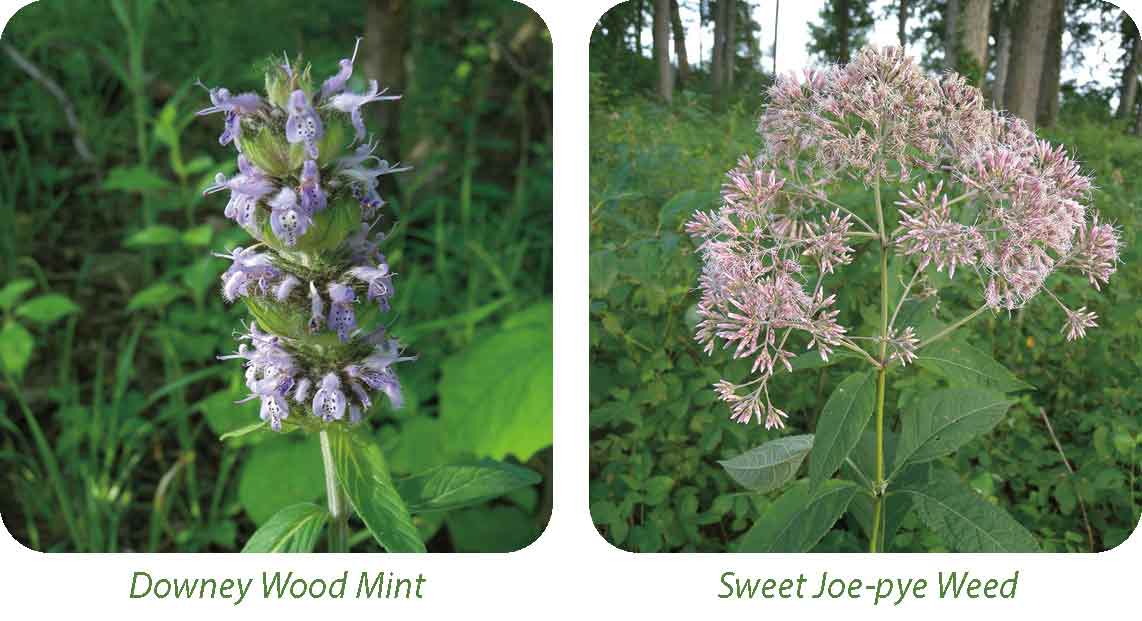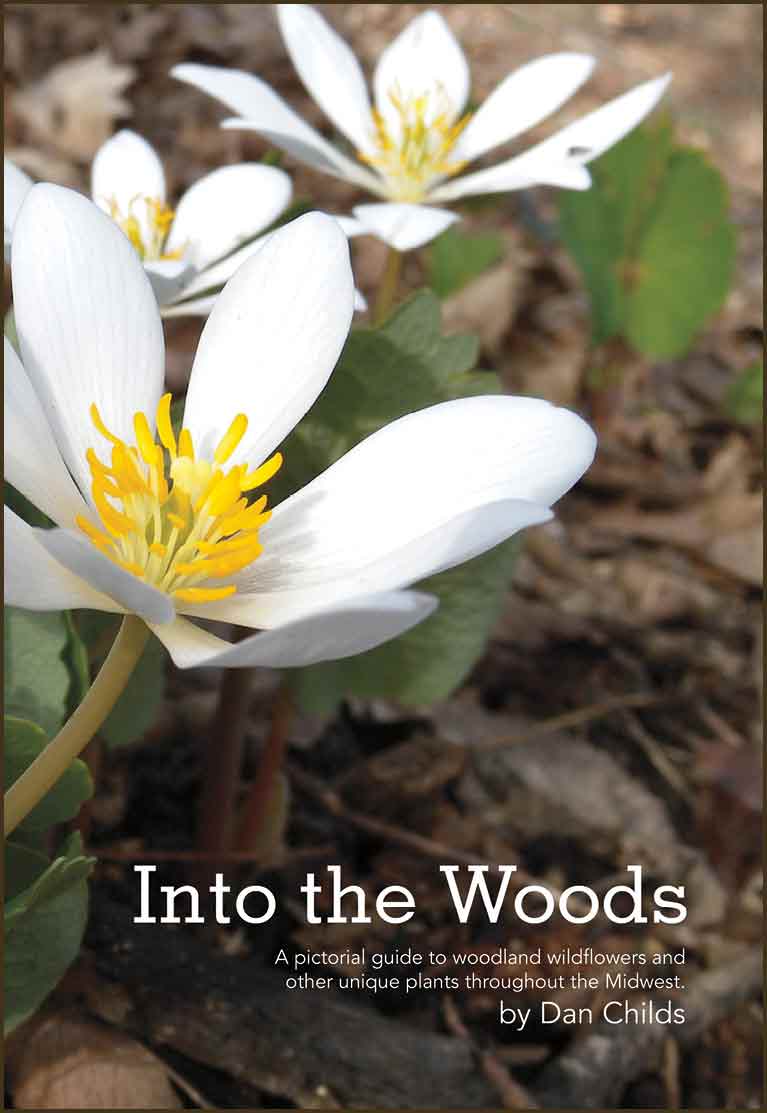Into the Woods
By Dan Childs
Growing up in rural southern Indiana, our church would often sponsor scavenger hunts for the teens in the community. These were fun activities to mainly keep us busy and out of trouble. But they also helped to promote team work, unity and a sense of accomplishment; all without the aid of smart phones and Google, I might add!
Scavenger hunts can also be a fun activity for you in your own woods or wherever you like to hike trails. This hunt involves searching for and identifying native wildflowers in bloom throughout the growing season. What follows is an outline of what to look for and record starting in early spring and commencing in late summer. So, grab a pencil and paper (or your smart phone) and make a list of these ten native wildflowers described in the following paragraphs and see if you can successfully find all ten specimens this year. I promise it will be a lot of fun, and it might even keep you out of trouble!
 March through April. The first herbaceous plant that flowers in the new year is Skunk Cabbage (Symplocarpus foetidus). You may be familiar with its large, broad leaves and colonies that sit on hillside seeps, but it does flower quite early. This unique plant, a member of the Arum family, produces an egg-shaped spadix that is covered by tiny yellow flowers, all enclosed in structure called a spathe. Even in late winter with snow covered ground, the spathe, through a process called the thermogenesis, warms the soil and punches through the cold woodland floor, then opens to expose the spadix and its tiny flowers.
March through April. The first herbaceous plant that flowers in the new year is Skunk Cabbage (Symplocarpus foetidus). You may be familiar with its large, broad leaves and colonies that sit on hillside seeps, but it does flower quite early. This unique plant, a member of the Arum family, produces an egg-shaped spadix that is covered by tiny yellow flowers, all enclosed in structure called a spathe. Even in late winter with snow covered ground, the spathe, through a process called the thermogenesis, warms the soil and punches through the cold woodland floor, then opens to expose the spadix and its tiny flowers.
Trilliums are the favorite of many woodland owners and spring hikers. Indiana is blessed with many different Trillium species. The first to bloom is Snow Trillium (Trillium nivale), and although it is the smallest member of the Trillium family, often signals that “spring is finally here!”.
Bloodroot (Sanguinaria canadensis) The bright white flowers with conspicuous yellow stamens are borne on a single stalk that appears to be growing up through the leaf. The underground rhizomes, stems and leaves all contain a reddish-orange sap – hence the name!
Virginia Bluebells (Mertensia virginica). The flowers start out as pink buds then turn into powder-blue, trumpet-shaped flowers which hang in clusters at the end of stems. Bonus points if you happen to spot a stray plant with an all white or all pink flower cluster.
Cutleaf Toothwort (Dentaria laciniata). A common plant found growing in large colonies in quality woods. Being a member of the mustard family, it has four petals that are white to light pink. Leaves are deeply lobed with jagged margins. Another member of the mustard family, the infamous Garlic Mustard, is not a friend of the woodland plant community and should be pulled up and disposed of when identified.
 May through June. Great Waterleaf (Hydrophyllum appendiculatum) often grows in large colonies. The leaves are large, five-lobed and resemble maple leaves. The showy, blueish-lavender flowers are five-petaled with dark blue or brown stamens. Some of the other Waterleaf members can be distinguished from one another by the split in the tip-end of the slender style (female flower part) – a hand lens requirement!
May through June. Great Waterleaf (Hydrophyllum appendiculatum) often grows in large colonies. The leaves are large, five-lobed and resemble maple leaves. The showy, blueish-lavender flowers are five-petaled with dark blue or brown stamens. Some of the other Waterleaf members can be distinguished from one another by the split in the tip-end of the slender style (female flower part) – a hand lens requirement!
Nothing brightens up a dark woodland understory more than Fire Pink (Silene virginica). It’s flashy red petals draws attention of the passerby, as well as important pollinators such as butterflies and hummingbirds. The “sticky” red flowers have petals with a notched tip, while Royal Catchfly a close relative of similar appearance, does not have the notch and generally blooms much later than Fire Pink.
Squawroot (Conopholis americana), resembling a pinecone, is a non-photosynthesizing parasitic plant that grows from the roots of oak trees where it gets its nourishment. The 4 to 8-inch flower stalk is fleshy and covered from base to tip with cream-colored flowers (later turning brown) and scales. If you find small clusters of these – look up! You are most likely standing underneath a mighty oak!
June through July. Downy Wood Mint (Blephilia ciliate) has a square stem and opposite leaves that are covered with small hairs. The flowers are clustered near the top of the central stem, are light purple to lavender and consist of two lips. The lower lip is speckled with dark purple spots that certainly help attract native pollinators to its flower.
 July through September. Last, but not least, and one of my personal favorites, is Sweet Joe-pye Weed (Eutrochium purpureum). This tall, erect plant has leaves in a whorled arrangement at each node. The showy inflorescence “dome” of light pink flowers is clustered at the top of the stems.
July through September. Last, but not least, and one of my personal favorites, is Sweet Joe-pye Weed (Eutrochium purpureum). This tall, erect plant has leaves in a whorled arrangement at each node. The showy inflorescence “dome” of light pink flowers is clustered at the top of the stems.
 If you would like to learn more about woodland wildflowers, a guide is now available to help identify these beautiful plants. The book, called Into the Woods, is a color photo guide of woodland wildflowers and other unique plants. It contains a glossary of botanical terms, flowering dates, pollinator information, plant status (native, non-native or invasive) and detailed plant descriptions. You can purchase the book online through Amazon.com (search: Into the Woods Dan Childs)
If you would like to learn more about woodland wildflowers, a guide is now available to help identify these beautiful plants. The book, called Into the Woods, is a color photo guide of woodland wildflowers and other unique plants. It contains a glossary of botanical terms, flowering dates, pollinator information, plant status (native, non-native or invasive) and detailed plant descriptions. You can purchase the book online through Amazon.com (search: Into the Woods Dan Childs)
